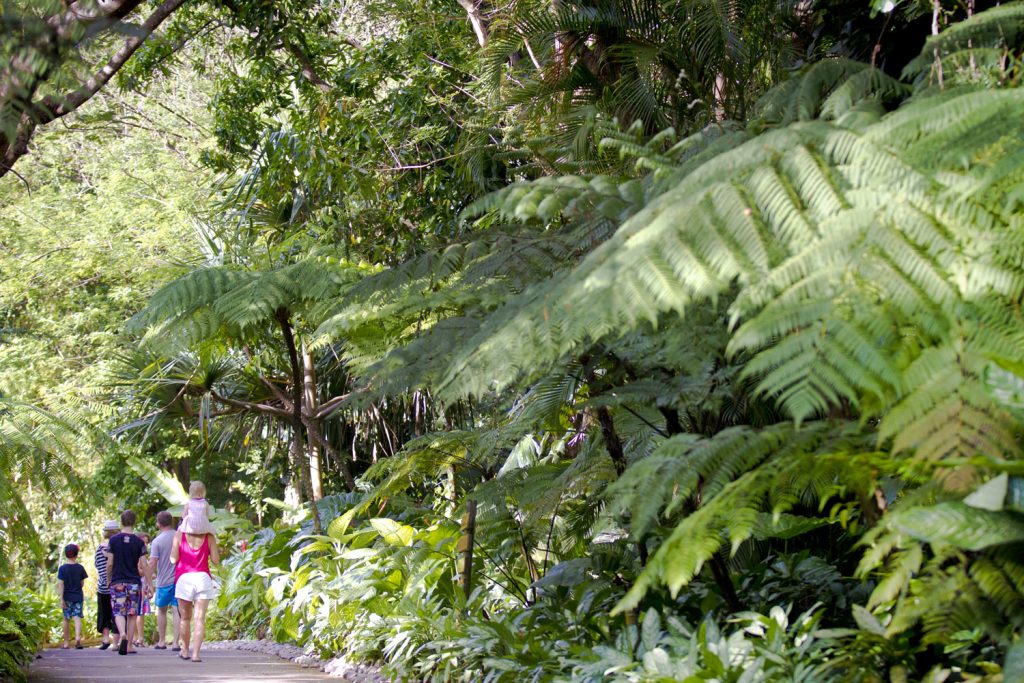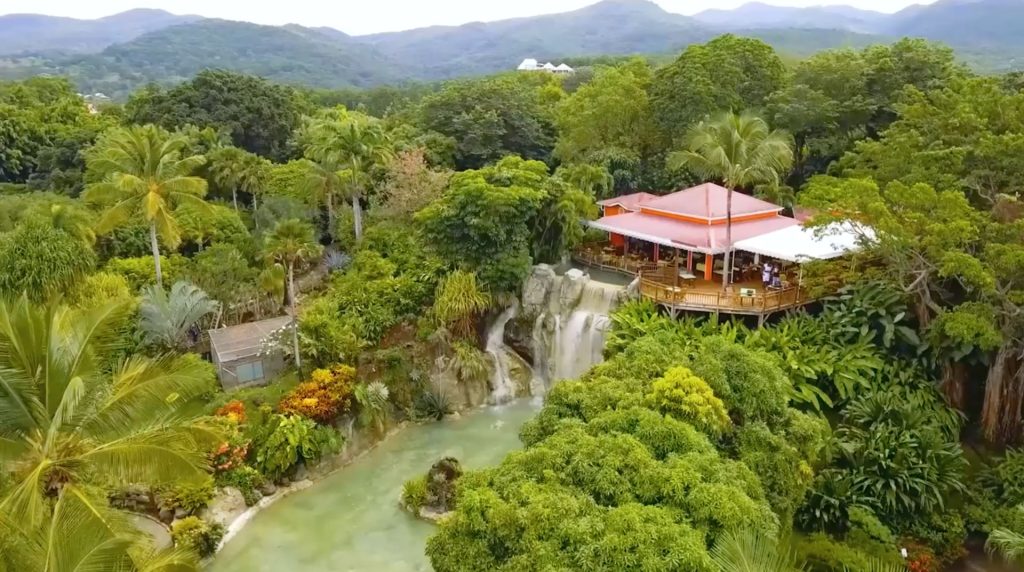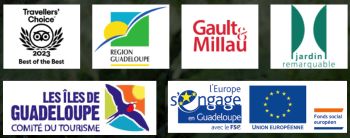 Garden and collections
Garden and collections
The garden is between 60 and 130 m above sea level.
The area is characterized by a semi-deciduous vegetation formation. However, the space has been modified and planted with native and exogenous species.
The garden is located at a place called Villers. It is located on a relatively steep hill, behind the coast on an area of approximately 5.5 Ha.
The forest structure has not been preserved.
Nevertheless, there are remarkable native species: courbaril Hymenaea courbaril , Fromager Ceiba pentandra, Red gum tree Bursera simaruba - Indian wood Pimenta racemosa, Country pear tree - Tabeuia heterophylla , Mango tree - Mangifera indica, etc.
A tour of approximately 1h30 to 2 hours which successively presents the various collections
To respect the tradition of botanical gardens, this park had to give a large place to plant collections.
Several areas of the garden are thus devoted to the presentation of families or species of plants: water lilies, orchids, hibiscus, bougainvillea, banana trees, succulents, palm trees... A maximum of varieties are grouped together there, to highlight their diversity and their qualities. ornamental.
These collections are not limited to the areas assigned to them and are dispersed throughout the garden. Some collections, such as those of the Héliconias, can only be discovered along the walk.
At the same time, an identity emerges from the different parts of the garden, real worlds different from each other.
 The different themes of the park
The different themes of the park
Located at the entrance to the park, an artificial pond more than 50m long and its magnificent collection of water lilies, papyrus and aquatic plants, among which evolve Koi carp.
Past the security gate, around thirty Lorikeets, small brightly colored Australian parrots welcome visitors, and do not hesitate to come and rest on their heads for a photo.
In a passage half shade, half sun, flowering orchids climb and intertwine on the trees. Different species provide a graceful and colorful spectacle. Fans of these flowers know their fragility and will appreciate the beauty of the varieties presented.
A colorful alley opens to visitors offering a remarkable palette of colors. The collection of presented varieties will not leave anyone indifferent.
A wide and airy space overlooking the Caribbean Sea, a multitude of trees make up the landscape: Royal Palms, Bombax, Baobab, Jacaranda, Breadfruit, Avocados, Calliandra and Araucaria.
Near the panoramic restaurant, this tree, impressive in its shape and its hundreds of aerial roots forming its trunk, was one of Coluche's favorite places.
10 meters high, the waterfall mixes natural and artificial rocks overlooked by the restaurant, enchants visitors who cross the basin by a small wooden bridge. The tradition is that you throw a coin in the water in the hope of seeing your wishes come true.
A few meters from the waterfall, an enclosure is reserved for 14 Caribbean red flamingos. They are the pioneers of a reintroduction of the species on the island. Indeed, before the 1940s, red flamingos lived in the region of Saint François.
A bamboo forest stands in the landscape, isolating visitors from the rest of the park. Several meters high, they offer a place of charm and freshness. Various species are represented such as the Bambusa Vulgaris, the Multip lex, the Aztecs.
A 60-meter torrent accompanies visitors throughout the course, bringing an atmosphere of serenity, amplified by the sound of the water, which flows at 150 m3/hour.
A wall of vegetated water 25 meters long surprises at the bend of a path and lets emerge aquatic plants such as water hyacinths with blue flowers, and many epiphyte plants (Bromeliads, Orchids and papyrus).
In this "village" made up of 6 small houses with local colors, the inhabitants are none other than ARAS parrots. These birds with flamboyant plumage presented in an open enclosure, represent the symbol of the tropical and equatorial forest.
An alley planted with different varieties of palm trees presents an idyllic aspect of the traditional landscape of the islands. The Double Royal Palm impresses with its originality. The passage under an arbor where climbing plants evolve, is refreshing thanks to a misting system.
This very rare palm is native to Sri Lanka. With a lifespan of between 80 and 100 years, it dies after giving its only flower. The first specimen planted in the park offered its undeniable magnificence for a few decades , before flowering and dying. His offspring joined him in the ground to take over.
From the lush vegetation of the islands, the route takes us to a desert and arid zone.
Dozens of species of cacti with more or less long spines stand in a Mexican setting, where Pachypodium (Madagascar palm) and Nolina beaucarnéa (elephant's foot) coexist. However, the highlight of the show is the collection of "Melocactus intortus" (English head) which is listed on the world's red list of endangered species.
The designers of the botanical garden could not forget to present the incredible beauty of tree ferns to the public. These ferns only flourish from an altitude of 500m, the park being located only 110m away, it was necessary to reconstitute the humid and cool climate of the mountain, by installing an irrigation system, by misting, programmed by computer. At the foot of these ferns have been planted numerous bromeliads and epiphytic plants, such as the philodendron giganteum.
Technologically, irrigation is a real innovation in the garden. In order to compensate for the excessive heat and to maintain the optimum humidity needed by the tropical vegetation, an aerial misting system is programmed by computer. This American process has been in operation since the end of the 1980s in the south of France and gained worldwide notoriety during the Universal Exhibition in Seville in 1992.



